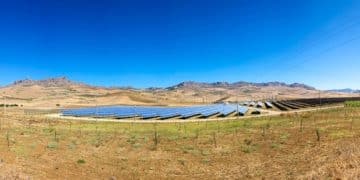Key Policy Changes for a Green Energy Transition in the US

The key policy changes needed to accelerate the transition to a green energy economy in the US include implementing comprehensive carbon pricing, expanding renewable energy standards, investing in grid modernization, and offering incentives for clean technology innovation and deployment.
The United States stands at a critical juncture in its energy future. Transitioning to a green energy economy is not just an environmental imperative but also an economic opportunity. But, what are the key policy changes needed to accelerate the transition to a green energy economy in the US?
Understanding the Urgency of Green Energy Transition
The urgency for a green energy transition stems from the increasingly apparent impacts of climate change. Extreme weather events, rising sea levels, and ecological disruptions underscore the need to shift away from fossil fuels. This section explores the pressing need for transitioning to green energy.
The Climate Crisis and Its Economic Impacts
The escalating climate crisis presents significant economic challenges. From the costs associated with disaster recovery to the long-term risks to agriculture and infrastructure, the financial implications are vast.
Transitioning to green energy offers a pathway to mitigate these risks and build a more resilient economy.
Benefits of a Green Energy Economy
A transition to green energy not only addresses climate concerns but also unlocks numerous economic benefits. Increased energy independence, job creation in emerging sectors, and reduced healthcare costs due to cleaner air are among the advantages.
- Reduced dependence on volatile global fossil fuel markets.
- Growth in renewable energy manufacturing and installation jobs.
- Innovation in energy storage and smart grid technologies.
The embrace of green energy has the chance to significantly uplift local economies while reducing environmental impact.
In summary, transitioning to a green energy economy reduces environmental damage while improving the USA’s economy.

Carbon Pricing Mechanisms: A Cornerstone Policy
Carbon pricing is widely recognized as a cornerstone policy for driving the green energy transition. By putting a price on carbon emissions, it incentivizes businesses and consumers to reduce their carbon footprint. In this section, we examine carbon pricing mechanisms and their potential impact.
Types of Carbon Pricing
There are two primary types of carbon pricing: carbon taxes and cap-and-trade systems. Carbon taxes impose a direct fee on carbon emissions, while cap-and-trade systems set a limit on overall emissions and allow companies to trade emission allowances.
Both approaches aim to internalize the environmental costs of carbon emissions, making cleaner energy sources more competitive.
Challenges and Considerations
Implementing carbon pricing policies can be politically challenging, particularly in regions heavily reliant on fossil fuels. Addressing concerns about economic competitiveness and ensuring equitable distribution of costs are crucial considerations.
- Concerns about increased energy costs for consumers.
- Risk of carbon leakage, where emissions shift to regions without carbon pricing.
- Need for revenue recycling to support affected industries and communities.
Despite the challenges, carbon pricing can be implemented to incentivize investments in renewable energy.
In conclusion, carbon pricing policies offer a powerful economic tool that should be explored. They foster innovation and guide businesses away from carbon-intensive practices.
Renewable Energy Standards: Mandating Green Power
Renewable Energy Standards (RES) mandate that a certain percentage of electricity sold by utilities comes from renewable sources. These standards create a guaranteed market for renewable energy, driving investment and deployment. This section assesses how RES works and its effects.
The Role of Renewable Portfolio Standards (RPS)
Renewable Portfolio Standards (RPS) are a specific type of RES that sets targets for the amount of renewable energy that utilities must include in their electricity mix. RPS policies vary by state, with some states setting ambitious goals for 100% renewable energy.
These standards set clear expectations, spurring investments in solar energy, wind energy and other renewables.
The Impact of Consistent Standards
The impact of consistent and well-enforced renewable energy standards is profound. They stimulate renewable energy development, reduce greenhouse gas emissions, and diversify energy sources, improving energy security.
Moreover, renewable facilities often revitalize rural communities, bringing jobs and tax revenue to those areas.
In conclusion, RES and RPS policies are vital to the wider adoption of renewable energy. They create consistent demand and incentivize utilities to invest in a greener future.

Investing in Grid Modernization and Energy Storage
Modernizing the grid and investing in energy storage is essential to accommodate the intermittent nature of renewable energy sources like solar and wind. A modern grid can efficiently transmit electricity from renewable energy sources to consumers, while energy storage technologies can store excess energy for later use.
Smart Grid Technologies
Smart grid technologies enable real-time monitoring and control of the electricity grid, improving its efficiency and reliability. Smart meters, advanced sensors, and data analytics can help utilities optimize energy distribution and respond quickly to grid disturbances.
These advancements can greatly improve grid resilience and efficiency.
The Importance of Energy Storage
Energy storage technologies, such as batteries and pumped hydro storage, play a crucial role in balancing the supply and demand of electricity. Energy storage can store excess renewable energy generated during peak production periods improving overall stability.
- Increased grid stability and reliability.
- Reduced need for fossil fuel peaking plants.
- Enhanced integration of distributed renewable energy resources.
Energy storage is vital for keeping the grid stable and working with renewable energy.
To conclude, investing in grid modernization and energy storage enables the US to make good use of green energy sources. It also ensures the electricity grid is up-to-date and sustainable.
Incentives for Clean Technology Innovation and Deployment
Government incentives play a critical role in driving innovation and deployment of clean technologies. Tax credits, grants, and loan programs can help reduce the financial risks associated with developing and deploying new technologies, encouraging investment and entrepreneurship.
Types of Incentives
Tax credits for renewable energy projects, such as the Investment Tax Credit (ITC) and the Production Tax Credit (PTC), have been instrumental in driving the growth of the solar and wind industries. Grants and loan programs, such as those offered by the Department of Energy, can support research, development, and demonstration of clean technologies.
These incentives reduce the financial risk and encourage companies to invest in green energy.
Maximizing effectiveness
To maximize the effectiveness of clean tech incentives, policies must be designed to encourage innovation and address both the economic and social impacts of transitioning technology while focusing on long-term sustainability and growth.
- Streamlining the permitting process for renewable energy projects.
- Providing workforce training and development programs to support the clean energy industry.
- Supporting research and development of advanced renewable energy technologies.
Consistent and broad policies can stimulate a lot of growth and development in the green energy field, while supporting new energy sources.
In conclusion, incentives help in growing clean tech by lowering barriers for investments and incentivizing research into the area.
Phasing Out Fossil Fuel Subsidies
Phasing out fossil fuel subsidies is a critical step in leveling the playing field for green energy. Fossil fuel subsidies distort energy markets, making it harder for renewable energy sources to compete. Eliminating these subsidies would free up resources that could be invested in clean energy.
The Impact on Green Energy
The impact of fossil fuel subsidies on green energy is substantial. These subsidies artificially lower the cost of fossil fuels, making them more attractive to consumers and businesses. Phasing out these subsidies would remove this artificial advantage, allowing green energy to compete on a more equal footing.
This can create a better market for green tech, leading to increased adoption of green solutions.
Strategies for Transition
Strategies for transitioning away from fossil fuel subsidies should be designed to minimize disruption and ensure a just transition for workers and communities dependent on the fossil fuel industry. Transitioning away from fossil fuels will likely be contentious; careful plans are necessary.
- Providing financial assistance to affected workers and communities.
- Investing in infrastructure to support the growth of clean energy industries.
- Implementing policies to promote energy efficiency and conservation.
Subsidies create financial imbalances when subsidies are given to fossil fuels, incentivizing fossil fuels over green options. Policies work to make green options more viable.
To summarize, removing fossil fuel subsidies creates a fair market for green energy to compete well.
Promoting Energy Efficiency and Conservation
Promoting energy efficiency and conservation is a cost-effective way to reduce energy consumption and greenhouse gas emissions. Energy-efficient buildings, appliances, and industrial processes can significantly lower energy demand, reducing the need for new power plants and lowering energy bills for consumers.
How Efficiency Aids the Transition
Energy efficiency aids the transition to a green energy economy by reducing overall energy demand which means that less capacity of renewables is needed. This integration makes electricity grids less stressed.
Therefore improving current processes improves adoption of green tech.
Implementing Better Standards
Implementing more standards, incentivizing consumers by providing rebates, and public education campaigns can help with better energy efficiency with these methods.
- Setting stronger energy efficiency standards for buildings and appliances.
- Providing financial incentives for energy-efficient upgrades.
- Promoting public awareness campaigns on the benefits of energy conservation.
In conclusion, by emphasizing energy efficiency in daily activities, we can reduce energy consumption. It is a cost-effective way of becoming more green.
| Key Aspect | Brief Description |
|---|---|
| 💰 Carbon Pricing | Incentivizes carbon footprint reduction through taxes or cap-and-trade systems. |
| ⚡ Renewable Standards | Mandates utilities to generate a set amount of electricity from green sources like solar and wind. |
| 🔋 Grid Modernization | Updates and improves electrical grids and energy storage to better handle green transitions. |
| 💡 Clean Innovation | Incentivizes the invention of clean technology via tax breaks and government funding. |
Frequently Asked Questions
A green energy economy is one that prioritizes renewable energy sources over non renewable. This typically necessitates policy changes to encourage the transition, such as tax incentives.
Renewable energy protects environments by reducing damage to wildlife, while reducing overall greenhouse emissions and other dangerous gasses. It also promotes job creation!
Carbon pricing puts a tax on companies that emit carbon, incentivizing them to go less carbon intensive. These carbon credits can also be traded on the open market.
It is important to create a renewable standard to ensure states generate a set amount of electricity from green sources. It also helps the electric grid become more green.
Energy distribution should be done with renewable sources in mind. This can mean modernizing grids to handle renewable fluxes and incentivizing energy efficiency.
Conclusion
In conclusion, transitioning to a green energy economy in the US requires a multifaceted strategy involving policy changes, technology investments, and changes to consumer behavior. Implementing carbon pricing mechanisms, setting renewable energy standards, modernizing the grid, incentivizing clean technology innovation, phasing out fossil fuel subsidies, and promoting energy efficiency are all essential steps in accelerating this transition.





